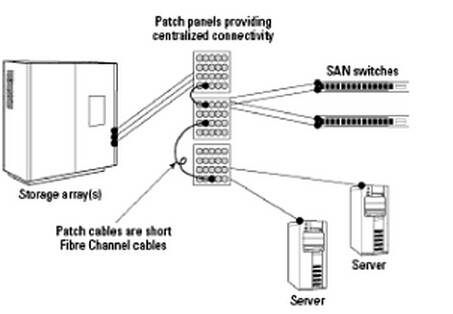We know, a good cable management system usually comes in the form of a rack or some type of 19″ rackmount panels that securely hold the cabling. The rack or panels have tracks where the cable run next to or inside your equipment racks so that can easily yet safely flow between one component and another.
Some of these system come with patch panels, which have rows of fiber optic ports on the front that allow you to connect the cables that come out of components ot other patch panels. Patch panels give you a prelabeled system you can use to interconnect your components without having to run new cabling every time you want to add to change something in your SAN layout. With patch panels, you hook up all the connection on each of change something in your SAN layout. With patch panels, you hook up all the connections on each of your components to the ports on the Fibre Optic Patch Panel. You run the fiber optic cables from your servers’ HBAs to a patch panel as well. All cabling is run en masse to the backs of these centrally located panels. When you want to connect components to your servers, you use short fiber optic cables (patch cables), usually less than 3 meters long (about 10 feet), to patch from your arrays to the ports of your switches to the ports for your HBAs.
The Figure show a typical patch panel solution connects your SAN components without requiring you to lift a floor tile or roll a spool of cable across the floor. Another benefit of using a patch panel is that running fiber optic cable on a one-by-one basis can be vary expensive. In larger data centers, the cabling is typically done by electricians – who, as we all know, cost money. The fewer times electricians have to come in to put in more cables, the better. Running a group of cables in one shot from the vary beginning is much cheaper and faster than doing it one bu one later.
Patch panel systems also male things very flexible. Now that you have all the endpoints of your SAN components in one place, you can easily control what talks to what by using the short, easy-to-manage patch cables.
The majority of manufacturers are making cable management a primary focus of new patch panel designs. Unicom’s Lara points out that “Cable management is a detail most often missed when installing a patch panel.” This has been a primary area of design focus for Unicom, he says, and the company recently introduced its front-access panel that lets all termination and cable management activity be conducted from the front. Available with either 12 or 24 Port Fiber Patch Panel, the front-termination patch panel can be a solution for installations where space is critical.
Fiberstore, one of famous Patch Panel Manufacturers, provides high bandwidth and mission critical physical infrastructures in data center, enterprise, and campus networks with comprehensive fiber optic systems that deliver high performance, reliability and scalability. By leveraging its technology leadership, innovative design and cable management expertise, Fiberstore fiber optic systems meet today’s requirements and provide a migration path for tomorrow’s applications. These advanced fiber optic systems include fiber optic cable, connectors, adapter modules, adapter panels, cassettes, enclosures, patch cords, cable assemblies, cable distribution products and accessories for both singlemode and multimode applications.
